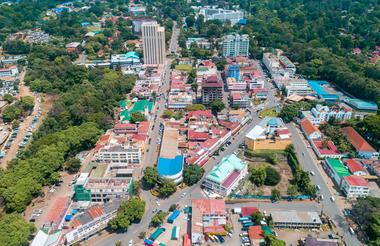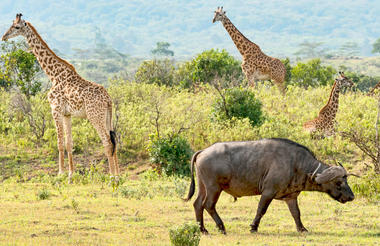Welcome to 🇹🇿 Tanzania!
- Meet our representative at Kilimanjaro International Airport [JRO]
- Road transfer to your hotel/lodge in Arusha
- Stay at Arusha Coffee Lodge for 1 night in BB
- Lunch and dinner are at your leisure
Arusha National Park
Arusha National Park is located in northern Tanzania, not too far south of the border of Kenya and just outside the city of Arusha. The national park encompasses an area of 53 square miles (137 sq km), making it one of the smaller national parks in Tanzania and the continent of Africa. Some consider this a sister park to Kilimanjaro just east of Arusha National Park. It is common for visitors to visit both parks, particularly those who have an affinity for mountains. Mount Meru is the second tallest mountain in Tanzania after Mount Kilimanjaro. Meru reaches a peak of 14,968 feet (4,562 m), which is quite a bit shorter than Kilimanjaro. On clear days, you can see either mountain from the other. Mount Meru is a dormant stratovolcano and the fifth-tallest mountain in Africa. Although the park is small by national park standards, it is diverse with facets of nature. There are three unique areas in the park. The Meru Crater is located in the western part of the park, providing runoff into the Jekukumia River. The summit is situated atop the rim of the crater. The southeastern part of Ngurdoto Crater has a rich grassland ecosystem. The northeastern part of the park is home to the Momella Lakes, a haven for birds that enjoy the growing algae in the lakes. The surrounding forest at the mountain's base is home to varied wildlife and many birds. Around 400 species of birds inhabit this park, making it a birdwatcher’s paradise. Other wildlife includes the black-and-white colobus monkey, buffalo, bushbuck, elephant, warthog, and zebra. The elusive leopard is present but hard to find.



- Airport road transfers
- Bed and breakfast accommodation
- Additional transfers
- Lunch and dinner
- All drinks
- Coffee Estates Tour
- Activities and attractions not stated as included or stated as recommended or optional
- Laundry
- Wifi might be available on purchase
- Meet your guide at your hotel in Arusha
- Quick briefing
- Road transfer and safari to the Ndutu region
Welcome to Ndutu Plains, in the Ngorongoro National Park!
- Stay at our Ndutu Safari Lodge for 3 nights
- Enjoy safaris in the Ndutu plains in its Predator Season
Ndutu Safari Lodge and Lake
A more energetic day might begin with an early morning bush breakfast during a game drive in one of many distinct landscape areas within the Ndutu Conservation Area: marshlands, acacia woodlands, soda lakes of Ndutu and Masek or the vast expanse of the Serengeti plains are all within easy reach – each with its distinct wildlife populations and seasonal visitors. For example, the marsh areas are favored by big cats to bring up their young, whereas the short grass plains are where Wildebeest babies are born during the Great Migration.
As the sun lowers, join the lodge team around the famous Ndutu campfire, watch the sunset spread across the plains, and the moon rises above the acacia trees. Or raise a glass or two around the bar to share stories and make new friends. As you return to your cottage full of good food and vivid memories from the day, listen for the haunting call of a hyena echoing through the woodlands before the velvet night brings restful sleep. Ndutu is in an area without tsetse fly, ensuring a peaceful stay.
The Lodge itself is also home to a long-standing population of sleek and graceful genets – patterned to camouflage into the shadows; these elegant nocturnal creatures can be glimpsed perching on the rafters of the mess area. The genets have come to enjoy the relaxed atmosphere as much as Ndutu’s visitors.
The lodge was founded in the late sixties and quickly established a reputation for the warm hospitality and delightful food, fast becoming a favorite stopover for pioneering naturalists, distinguished zoologists, and photographers such as celebrated primatologist Jane Goodall and renowned wildlife filmmaker Hugo van Lawick who researched, filmed and wrote about wild dogs in the area. George Dove was great friends with Mary Leakey, a pioneering archaeologist who discovered some of the first fossils of human ancestors nearby.



Migration Season - mid-December – April
Traveling down from Kenya every year the Ngorongoro Conservation Area (NCAA) plays host to one of the world’s greats natural spectacles – The Great Migration. Over two million migratory animals made up of several species wildebeest, zebra, eland, and Thompson gazelle move clockwise from Ngorongoro and the Southern Serengeti to the Northern Serengeti into Kenya and back. This migration route happens because they follow the rains and therefore the new grasses which grow up rapidly. The Ndutu area is famed for its short grass plains which grow grass which is particularly rich in nutrients and sustains the migratory animals whilst they have their babies. Traditionally the wildebeest and zebra tend to calve on these plains with a peak around February which makes for a beautiful natural spectacle and some exciting predator hunting behaviors. The Wildebeest continue to mature on the short grass plains well into March and April gaining strength for the long migration to the North following the rains and the new pastures.
Predator Season - April – mid-December
When migrating wildlife has moved on to follow the rains the landscape of Ndutu changes dramatically into a dry dramatic landscape of muted greens and greys with Lake Ndutu occasionally drying to a bleached white salt pan. This is a great season to really enjoy the resident predators of Ndutu and indeed Ndutu is a favorite of expert guides, scientists and biologists for its high numbers of cats including lion, leopard, cheetah, civet, serval, wild cat and caracal. The resident predators are territorial and so once they have had their young they remain at Ndutu in the local marsh areas which stay wet all year round and are an essential freshwater source for the herbivores, therefore, attracting predators. The marshes also serve as the ideal place for cheetah and lion to hide their offspring from danger. You can enjoy sightings of all three species of jackal including the rarely seen side-striped jackal and in the late afternoons, you may glimpse striped hyena at the lakeshore. The wonderful thing about doing a game drive during this dry season is that the behaviours of these animals are more visible due to the lack of vegetation. The variety of habitats allows plenty of places to explore and you often find yourself having private encounters with predators.
Safaris in Ndutu Lake Region
- Private vehicle and guide
- Road transfer to Ndutu
- Accommodation in stone and thatched cottage
- Breakfast, lunch and dinner - On transfer day: picnic lunch
- Complimentary tea and coffee
- Ngorongoro NP Concession and Conservation Area fees
- Safaris in the Ndutu region
- Complimentary Wifi in common areas
- Additional transfers
- Safaris in Serengeti NP
- All drinks
- Olduvai Gorge visit
- Hot Air Balloon flight
- Activities and attractions not stated as included or stated as recommended or optional
- Laundry
- Road transfer and safari to Naabi Hills, Serengeti southern gate
Welcome to the magic Serengeti National Park!
- Safari in southern Serengeti and transfer to your camp
- Stay at Serengeti Pioneer Camp for 4 nights
Serengeti National Park
It is the most famous park in Tanzania, UNESCO World Heritage, and probably the most famous in the World for wildlife viewing.
The park covers 5,700 sq mi (14,760 sq km), it is larger than Connecticut, and it is a massive landscape of grassland plains, savanna, riverine forest, and woodlands. It lies in northwestern Tanzania, bordered to the north by the Kenyan border, where it is continuous with the Maasai Mara National Reserve. To the southeast of the park is the Ngorongoro Conservation Area. To the southwest lies Maswa Game Reserve. To the west are the Ikorongo and Grumeti Game Reserves. To the northeast and east lies the Loliondo Game Control Area. Together, these areas form the larger Serengeti ecosystem and the legendary Great Serengeti Migration, a stunning natural spectacle.
The park is usually described as divided into three regions:
- Serengeti plains: the almost treeless grassland of the south is the most emblematic scenery of the park. This is where the wildebeest breed, as they remain in the plains from December to May.
- Western corridor: the black clay soil covers the savannah of this region. The Grumeti River and its gallery forests are home to Nile crocodiles, patas monkeys, hippopotamus, and martial eagles. The migration passes through from May to July.
- Northern Serengeti: the landscape is dominated by open woodlands and hills, ranging from Seronera in the south to the Mara River on the Kenyan border. Apart from the migratory wildebeest and zebra (which occur from July to August and in November), this is the best place to find the elephant, giraffe, and dik-dik.
The migratory -and some resident- wildebeest, which number over 2 million individuals, constitute the largest population of big mammals that still roam the planet. They are joined in their journey through the Serengeti - Mara ecosystem by 250,000 plains zebra, half a million Thomson's and Grant's gazelle, and tens of thousands of topi and Coke's hartebeest. Masai giraffe, waterbuck, impala, warthog, and hippo are also abundant. Some rarely seen antelope species are also present in Serengeti National Park, such as common eland, klipspringer, roan antelope, bushbuck, lesser kudu, fringe-eared oryx, and dik-dik.



The Great Migration
The wildebeest migration is one of Africa's greatest wildlife spectacles. At least two million ungulates – mainly wildebeest, but also zebra and gazelle – move around the Mara-Serengeti ecosystem. The wildebeest calving season is also a very special time to visit. The large concentrations of wildebeest and their calves attract many opportunistic predators, and this is a good time to see some action.
It is impossible to predict the exact time of the Migration. The key element in understanding ”The Greatest Wildlife Show on Earth” is that it follows the general rainfall gradient across the ecosystem, with lower rainfalls in the short-grass plains of the southeast and the higher rainfall in the northwest, that involves 3 of the most spectacular wildlife parks: the Masai Mara, in Kenya and the Ngorongoro Conservation Area and the Serengeti National Park, in Tanzania.
The best chance for seeing the wildebeest migration is during June and July and the time to see the wildebeest calving in the Serengeti is late January to February. The Dry season (late June to October) is generally the best time for wildlife viewing throughout. At this time, the bush is less dense, and animals tend to congregate around waterholes. The Wet season (November-May) is often more beautiful when the parks are green, and tourist numbers are lower. The parks in the Southern and Western circuits are less accessible in the long rains (March to May) and some lodges close in that period.
Safaris in Serengeti National Park
- Private vehicle and guide
- Safaris in Serengeti NP
- Breakfast, lunch, and dinner - On transfer day: picnic lunch
- House brand drinks
- Serengeti NP Park and Concession fees
- Premium drinks
- Activities and attractions not stated as included or stated as recommended or optional
- Laundry
- Wifi might be available on purchase
- Safari and road transfer to the Ngorongoro region
- Stay at The Manor at Ngorongoro for 2 nights
Welcome to "The Crater"!
- On the second day, early morning start and full-day safari in the Ngorongoro Crater
Ngorongoro Crater
The Ngorongoro Conservation Area is a protected area and a UNESCO World Heritage Site located 110 mi (180 km) west of Arusha in Tanzania's Crater Highlands area.
The main feature of the Ngorongoro Conservation Area is the Ngorongoro Crater, the world's largest inactive, intact and unfilled volcanic caldera. The crater, which formed when a large volcano exploded and collapsed on itself two to three million years ago, is 2,000 feet deep, and its floor covers 100 square miles. Seven Natural Wonders voted the crater as one of the Seven Natural Wonders of Africa in Arusha, Tanzania, in February 2013.
Approximately 25,000 large animals live in the crater. Large mammals in the crater include black rhinoceros, the African buffalo or Cape buffalo, and hippo.
Although conceived as "a natural enclosure" for an extensive variety of wildlife, 20 percent or more of the wildebeest and half the zebra populations vacate the crater in the wet season, while Cape buffalo stay; their highest numbers are during the rainy season.
A safari holiday in Tanzania is not complete without a descent to the mighty Ngorongoro Crater.



- Private vehicle and guide
- Road transfer to the Ngorongoro region
- Breakfast, dinner, and picnic lunch
- House brand drinks
- Ngorongoro NP Park and Concession fees
- Ngorongoro Crater travelers and vehicle fees
- Premium drinks
- Activities and attractions not stated as included or stated as recommended or optional
- Laundry
- Wifi might be available on purchase
- Private road transfer to Arusha
- Stay at Arusha Coffee Lodge for 1 night in BB
- Lunch and dinner are at your leisure



- Road transfer
- Bed and breakfast accommodation
- Additional transfers
- Lunch and dinner
- All drinks
- Coffee Estates Tour
- Activities and attractions not stated as included or stated as recommended or optional
- Laundry
- Wifi might be available on purchase
- Road transfer from your lodge in Arusha to Kilimanjaro International Airport [JRO]
- Breakfast
- Road transfer to JRO





